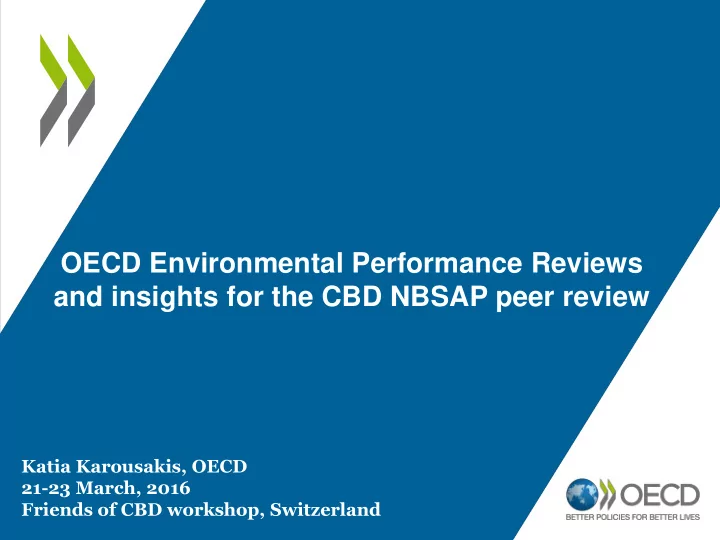

OECD Environmental Performance Reviews and insights for the CBD NBSAP peer review Katia Karousakis, OECD 21-23 March, 2016 Friends of CBD workshop, Switzerland
Content • OECD Environmental Performance Reviews – Objective – EPR cycle – Timeline and logistics – Structure and content of EPR and biodiversity chapters • Comparison of some review mechanisms • Insights and key questions for the voluntary NBSAP peer review 2
OECD Environmental Performance Reviews Objective and value-added • The OECD uses peer reviews in several areas of its work (environmental performance reviews, economic surveys, agriculture reviews…) • The Environmental Performance Review (EPR) programme was launched in 1992: Helping countries assess progress in meeting national and international commitments Stimulating greater accountability to other countries and to the public Improve the individual and collective environmental performance of OECD members and partners 3
What do we mean by “Environmental performance”? • Have national and international environmental policy objectives been achieved (i) efficiently and (ii) effectively? • Are the policy objectives based on an assessment of benefits and costs? Performance: • intentions actions results • Assessment in the economic, institutional, social and environmental context of each country In comparison with other countries • 4
EPR cycle Information collection (questionnaire) Review mission (meetings with environment and other ministry officials, representatives of industry, trade unions, NGOs, independent experts and local governments) Preparation of report by the Secretariat Peer review discussion in Paris A&Rs Finalisation, publication and launch (Voluntary) Mid-term progress report ( self-assessment by country) 5
Logistics (resources and time) • Review team (6-9 members) – typically includes Secretariat staff and experts from two reviewing countries • 12-16 months total – 4-7 days mission to country – Time to complete one chapter: 8 weeks min . ◦ About 20-30 pages per chapter 6
Structure/content of EPRs • Progress towards sustainable development (3 chapters) – Key environmental trends – Policy-making environment – Towards green growth • Progress towards two selected environmental objectives (2 chapters) – e.g., Biodiversity, climate change, water, waste, etc. – 12* out of the 23 countries reviewed in 2010-16 selected biodiversity as one fo the 2 themes for in-depth review *Brazil, Chile, Colombia, France, Israel, Japan, Mexico, Norway, Poland, South Africa, Spain, Sweden • Assessment and Recommendations 7
Structure/content of OECD EPR biodiversity chapters • State and trends in biodiversity/ecosystems • Institutional and regulatory/legal framework – including e.g. international co-operation and finance • Policy instruments for biodiversity conservation and sustainable use – Regulatory, economic, and information/voluntary instruments, and the policy mix • Mainstreaming biodiversity in other key sectors/ policy areas – e.g. agriculture, fisheries, forestry, mining, etc 8
Comparing some review mechanisms… OECD EPR biodiversity UNFCCC Review of Annex I CBD NBSAP review National Communications and implementation chapters Broad – national Scope Broad – national biodiversity Broad – national climate objective and biodiversity objectives objectives and implementation implementation and implementation Objective To help countries improve their individual To assess the implementation of commitments and collective performances in environmental under the UNFCCC and to ensure the COP has management by assisting them in carrying accurate, consistent and relevant information at out national evaluations, promoting dialogue its disposal. between countries and enhancing accountability. Includes Assessment & Recommendations No Assessment & Recommendations # of 34 OECD member countries, as well The 42 Parties included in Annex I to 196 ? countries to as non-OECD countries on request the UNFCCC be reviewed Turnover 3-4 EPRs per year >>Every 4 years ? Composition The ERT is composed of OECD Secretariat A geographically balanced team of international TBD? staff and experts from other member experts serving in their personal capacity, of review countries, sometimes other international selected from a roster of experts nominated by team organisations. countries and organisations and co-ordinated by the UNFCCC secretariat. They must not be from, or nominated by, the Party under review. Participation International organisations, academic Intergovernmental organisations are invited to TBD? institutions, industry and NGOs are also contribute staff and/or resources to assist with of other consulted during the in-country review the review. stakeholders 9 Source: Adapted from Annex A in Ellis et al (2011). OECD/IEA CCXG paper no. 2011(4)
Insights and lessons for the CBD NBSAP peer review Clearly understand objective (and intended output) of the NBSAP • review, and why Is it a collection of facts? An evaluation? And also recommendations? This has implications on what “model” to use, and on resources and time • Develop a template for key issues to address (including consistent structure of review documents) Collect information (via questionnaire) and draft preliminary review • in advance of mission • Ask consistent questions across each country Review team should best include 1-2 permanent staff (otherwise, • consistency across e.g. evaluations is difficult to ensure) 10
Thank you! What’s happening for biodiversity in 2015-2016 (on-going OECD projects): Biodiversity and Development: Mainstreaming and Managing for Results Marine Protected Areas: Economics, Management and Policy Barriers to Effective Biodiversity Policy Reform Visit: www.oecd.org/env/biodiversity and www.oecd.org/env/countryreviews Katia Karousakis , OECD Environment Directorate, Biodiversity Team Lead katia.karousakis@oecd.org Ivana Capozza , OECD Environment Directorate, EPR Team Lead ivana.capozza@oecd.org 11
Recommend
More recommend